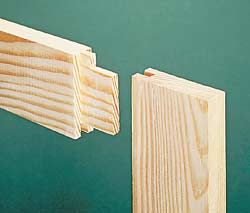*



 The Hounch Joint
The Hounch Joint
« on: Today at 05:14:07 PM »

In a post on SAPFM: 19th Jan 07, bill Sutton claimed this: I don't think there is any significant structural advantage provided by a haunch; in fact I think it could be argued that it may actually weaken the post.
Can I take: Post, to mean a stile. (English termination)
Well to me? either way, that is bad advice.
For on a chair leg/rail joints for example, the haunch is there to? Stop the (haunch) end, or if used Ordinary mortise joint, twisting, inward or outward? Causing the glue joint to fail, thus needs a repair,
. By including a ¼” long haunch on a tennon, the mortise & tennon joint is connected the full width of the rail, at the joint line /same at the mortise. Making a joint that can never twist out of alignment.
The same rule applies: with a house door, a window frame, paneling, or furniture.
Remember: Haunch joints are there for a purpose, to make a stronger joint.
The truth must be told.
www.ncwoodworker.net/pp/data/500/thumbs/Picture_037.jpg




 The Hounch Joint
The Hounch Joint « on: Today at 05:14:07 PM »


In a post on SAPFM: 19th Jan 07, bill Sutton claimed this: I don't think there is any significant structural advantage provided by a haunch; in fact I think it could be argued that it may actually weaken the post.
Can I take: Post, to mean a stile. (English termination)
Well to me? either way, that is bad advice.
For on a chair leg/rail joints for example, the haunch is there to? Stop the (haunch) end, or if used Ordinary mortise joint, twisting, inward or outward? Causing the glue joint to fail, thus needs a repair,
. By including a ¼” long haunch on a tennon, the mortise & tennon joint is connected the full width of the rail, at the joint line /same at the mortise. Making a joint that can never twist out of alignment.
The same rule applies: with a house door, a window frame, paneling, or furniture.
Remember: Haunch joints are there for a purpose, to make a stronger joint.
The truth must be told.
www.ncwoodworker.net/pp/data/500/thumbs/Picture_037.jpg




